Integrated Health Interventions for Improved Livelihoods: A Case Study in Ethiopia
Abstract
1. Introduction
2. Study Contexts and the Interventions
2.1. The Study Area
2.2. The Integrated Health Interventions
2.2.1. Tsetse Fly Control
2.2.2. Mosquito Control
2.2.3. Maize Stemborer Control
2.2.4. Improved Beekeeping
2.2.5. Expected Synergies Between and Among the Interventions
3. Materials and Methods
3.1. Data Sources
3.2. Empirical Methodology
3.2.1. Conceptual Framework
3.2.2. Empirical Model
Model Activities
Model Constraints
3.2.3. Scenarios for Evaluating the Benefits of Interventions
4. Results and Discussions
4.1. Estimated Economic Benefits of the Interventions
4.2. Impacts on Land Productivity
5. Conclusions and Policy Implications
Author Contributions
Funding
Conflicts of Interest
References
- Berger, T.; Troost, C. Agent-based modelling of climate Adaptation and mitigation options in agriculture. J. Agric. Econ. 2014, 65, 323–348. [Google Scholar] [CrossRef]
- Antle, J.M.; Stoorvogel, J.J.; Valdivia, R.O. New parsimonious simulation methods and tools to assess future food and environmental security of farm populations. Philos. Trans. R. Soc. B Biol. Sci. 2014, 369, 20120280. [Google Scholar] [CrossRef] [PubMed]
- Alliance for a Green Revolution in Africa. AGRA Africa Agriculture Report: Climate Change and Smallholder Farmers in Sub-Saharan Africa; Alliance for a Green Revolution in Africa: Nairobi, Kenya, 2014. [Google Scholar]
- Harvey, C.A.; Rakotobe, Z.L.; Rao, N.S.; Dave, R.; Razafimahatratra, H.; Rabarijohn, R.H.; Rajaofara, H.; MacKinnon, J.L. Extreme vulnerability of smallholder farmers to agricultural risks and climate change in Madagascar. Philos. Trans. R. Soc. B Biol. Sci. 2014, 369, 20130089. [Google Scholar] [CrossRef] [PubMed]
- McDowell, J.Z.; Hess, J.J. Accessing adaptation: Multiple stressors on livelihoods in the Bolivian highlands under a changing climate. Glob. Environ. Chang. 2012, 22, 342–352. [Google Scholar] [CrossRef]
- Hertel, T.W.; Rosch, S.D. Climate change, agriculture, and poverty. Appl. Econ. Perspect. Policy 2010, 32, 355–385. [Google Scholar] [CrossRef]
- Berger, T.; Troost, C.; Wossen, T.; Latynskiy, E.; Tesfaye, K.; Gbegbelegbe, S. Can smallholder farmers adapt to climate variability, and how effective are policy interventions? Agent-based simulation results for Ethiopia. Agric. Econ. (UK) 2017, 48, 693–706. [Google Scholar] [CrossRef]
- Wossen, T.; Berger, T.; Haile, M.G.; Troost, C. Impacts of climate variability and food price volatility on household income and food security of farm households in East and West Africa. Agric. Syst. 2018, 163, 7–15. [Google Scholar] [CrossRef]
- van Ginkel, M.; Sayer, J.; Sinclair, F.; Aw-Hassan, A.; Bossio, D.; Craufurd, P.; El Mourid, M.; Haddad, N.; Hoisington, D.; Johnson, N.; et al. An integrated agro-ecosystem and livelihood systems approach for the poor and vulnerable in dry areas. Food Secur. 2013, 5, 751–767. [Google Scholar] [CrossRef]
- Haider, L.J.; Boonstra, W.J.; Peterson, G.D.; Schlüter, M. Traps and Sustainable Development in Rural Areas: A Review. World Dev. 2018, 101, 311–321. [Google Scholar] [CrossRef]
- Enfors, E. Social-ecological traps and transformations in dryland agro-ecosystems: Using water system innovations to change the trajectory of development. Glob. Environ. Chang. 2013, 23, 51–60. [Google Scholar] [CrossRef]
- Banerjee, A.; Duflo, E.; Goldberg, N.; Karlan, D.; Osei, R.; Parienté, W.; Shapiro, J.; Thuysbaert, B.; Udry, C. A multifaceted program causes lasting progress for the very poor: Evidence from six countries. Science 2015, 348, 1260799. [Google Scholar] [CrossRef] [PubMed]
- Sachs, J. The End of Poverty: Economic Possibilities for Our Time; Penguin Books: New York, NY, USA, 2005. [Google Scholar]
- Bandiera, O.; Burgess, R.; Das, N.; Gulesci, S.; Rasul, I.; Sulaiman, M. Labor Markets and Poverty in Village Economies. Q. J. Econ. 2017, 132, 811–870. [Google Scholar] [CrossRef]
- Alkire, S.; Santos, M.E. Measuring acute poverty in the developing world: Robustness and scope of the Multidimensional Poverty Index. World Dev. 2014, 59, 251–274. [Google Scholar] [CrossRef]
- Maru, Y.T.; Fletcher, C.S.; Chewings, V.H. A synthesis of current approaches to traps is useful but needs rethinking for indigenous disadvantage and poverty research. Ecol. Soc. 2012, 17, 324–338. [Google Scholar] [CrossRef]
- Lade, S.J.; Haider, L.J.; Engström, G.; Schlüter, M. Resilience offers escape from trapped thinking on poverty alleviation. Sci. Adv. 2017, 3, e1603043. [Google Scholar] [CrossRef] [PubMed]
- Barrett, C.B.; Swallow, B.M. Fractal poverty traps. World Dev. 2006, 34, 1–15. [Google Scholar] [CrossRef]
- WHO. WHO Global Malaria Programme. In World Malaria Report 2015; World Health Organisation: Geneva, Switzerland, 2015. [Google Scholar]
- Asenso-Okyere, K.; Asante, F.A.; Tarekegn, J.; Andam, K.S. A review of the economic impact of malaria in agricultural development. Agric. Econ. 2011, 42, 293–304. [Google Scholar] [CrossRef]
- Alsan, M. The Effect of the TseTse Fly on African Development. Am. Econ. Rev. 2015, 105, 382–410. [Google Scholar] [CrossRef]
- Shaw, A.P.M.; Cecchi, G.; Wintd, G.R.W.; Mattiolie, R.C.; Robinson, T.P. Mapping the economic benefits to livestock keepers from intervening against bovine trypanosomosis in Eastern Africa. Prev. Vet. Med. 2014, 113, 197–210. [Google Scholar] [CrossRef]
- Swallow, B.M. Impact of trypanosomiasis on African agriculture. In PAAT Technical and Scientific Series 2; Food and Agriculture Organization: Rome, Italy, 2000. [Google Scholar]
- FAO. The Disease. Programme Against African Trypanosomosis (PAAT). Food and Agriculture Organization of the United Nations (FAO). Available online: http://www.fao.org/paat/the-programme/the-disease/en/ (accessed on 8 April 2019).
- Barrett, J.C. Economic issues in trypanosomiasis control. In NRI Bulletin 75; Natural Resources Institute Chatham: Chatham, UK, 1997. [Google Scholar]
- Cecchi, G.; Mattioli, R.C. Global Geospatial Datasets for African Trypanosomiasis Management: A Review; United Nations Food and Agriculure Organization (FAO): Rome, Italy, 2009. [Google Scholar]
- Kabayo, J.P. Aiming to eliminate tsetse from Africa. Trends Parasitol. 2002, 18, 473–475. [Google Scholar] [CrossRef]
- Shiferaw, B.; Prasanna, B.M.; Hellin, J.; Bänziger, M. Crops that feed the world 6. Past successes and future challenges to the role played by maize in global food security. Food Secur. 2011, 3, 307–327. [Google Scholar] [CrossRef]
- Prasanna, B. Maize in the developing world: Trends, challenges and opportunities. In Proceedings of the International Maize Conference, Nanning, China, 12–18 October 2015; Volume 5, pp. 26–38. [Google Scholar]
- De Groote, H. Maize yield losses from stemborers in Kenya. Insect Sci. Appl. 2002, 22, 89–96. [Google Scholar] [CrossRef]
- Samuel, A.O.; Tabbassum, B.; Sharif, M.N.; Bhatti, M.U.; Nasir, I.A.; Husnain, T. A lag in the advancement of biotechnology: Reliable control of maize stem borers in Africa. J. Plant Prot. Res. 2018, 58, 8–24. [Google Scholar]
- Kfir, R.; Overholt, W.A.; Khan, Z.R.; Polaszek, A. Biology and management of economically important Lepidopteran cereal stem borers in Africa. Annu. Rev. Entomol. 2002, 47, 701–731. [Google Scholar] [CrossRef] [PubMed]
- Barofsky, J.; Anekwe, T.D.; Chase, C. Malaria eradication and economic outcomes in sub-Saharan Africa: Evidence from Uganda. J. Health Econ. 2015, 44, 118–136. [Google Scholar] [CrossRef] [PubMed]
- Lucas, A.M. Malaria eradication and educational attainment: Evidence from paraguay and sri lanka. Am. Econ. J. Appl. Econ. 2010, 2, 46–71. [Google Scholar] [CrossRef]
- Shaw, R.; Witt, A.; Cock, M.; Pollard, K.; Thomas, S.; Romney, D. Safeguarding the environment, food security and livelihoods from invasive species using biological controls. In CABI Study Brief 4; CABI: Wallingford, UK, 2014. [Google Scholar]
- Kipkoech, K.A.; Schulthess, F.; Yabann, W.K.; Maritim, H.K.; Erick, M.; Mithöfer, D. The economic value of releasing parasitoid for the control of maize stemborers in East and Southern Africa. In Proceedings of the International Association of Agricultural Economists (IAAE) Conference, Beijing, China, 16–22 August 2009. [Google Scholar]
- Kristjanson, P.M.; Swallow, B.M.; Rowlands, G.J.; Kruska, R.L.; de Leeuw, P.N. Measuring the costs of African animal trypanosomosis, the potential benefits of control and returns to research. Agric. Syst. 1999, 59, 79–98. [Google Scholar] [CrossRef]
- De Groote, H.; Wangare, L.; Kanampiu, F.; Odendo, M.; Diallo, A.; Karaya, H.; Friesen, D. The potential of a herbicide resistant maize technology for Striga control in Africa. Agric. Syst. 2008, 97, 83–94. [Google Scholar] [CrossRef]
- Kassie, M.; Stage, J.; Diiro, G.; Muriithi, B.; Muricho, G.; Ledermann, S.T.; Pittchar, J.; Midega, C.; Zeyaur, K. Push–pull farming system in Kenya: Implications for economic and social welfare. Land Use Policy 2018, 77, 186–198. [Google Scholar] [CrossRef]
- Soul-kifouly, G.M.; Affognon, H.D.; Macharia, I.; Ong’amo, G.; Abonyo, E.; Ogola, G.; De Groote, H.; LeRu, B. Assessing the long-term welfare effects of the biological control of cereal stemborer pests in East and Southern Africa: Evidence from Kenya, Mozambique and Zambia. Agric. Ecosyst. Environ. 2016, 230, 10–23. [Google Scholar] [CrossRef]
- Twomlow, S.; Shiferaw, B.; Cooper, P.; Keatinge, J.D.H. Integrating genetics and natural resource management for technology targeting and greater impact of agricultural research in the semi-arid tropics. Exp. Agric. 2008, 44, 235–256. [Google Scholar] [CrossRef]
- Giller, K.E.; Witter, E.; Corbeels, M.; Tittonell, P. Field Crops Research Conservation agriculture and smallholder farming in Africa: The heretics’ view. Field Crop. Res. 2009, 114, 23–34. [Google Scholar] [CrossRef]
- Kiptot, E.; Hebinck, P.; Franzel, S.; Richards, P. Adopters, testers or pseudo-adopters? Dynamics of the use of improved tree fallows by farmers in western Kenya. Agric. Syst. 2007, 94, 509–519. [Google Scholar] [CrossRef]
- Glăvan, B. Coordination Economics, poverty traps, and the market process: A New Case Ind. Policy? Indep. Rev. 2008, 13, 225–243. [Google Scholar]
- Rodríguez-Clare, A. Coordination failures, clusters, and microeconomic interventions. Economía 2005, 6, 1–42. [Google Scholar] [CrossRef]
- Teklewold, H.; Kassie, M.; Shiferaw, B.; Köhlin, G. Cropping system diversification, conservation tillage and modern seed adoption in Ethiopia: Impacts on household income, agrochemical use and demand for labor. Ecol. Econ. 2013, 93, 85–93. [Google Scholar] [CrossRef]
- Kassie, M.; Teklewold, H.; Marenya, P.; Jaleta, M.; Erenstein, O. Production risks and food security under alternative technology choices in Malawi: Application of a multinomial endogenous switching regression. J. Agric. Econ. 2015, 66, 640–659. [Google Scholar] [CrossRef]
- Wainaina, P.; Tongruksawattana, S.; Qaim, M. Tradeoffs and complementarities in the adoption of improved seeds, fertilizer, and natural resource management technologies in Kenya. Agric. Econ. 2016, 47, 351–362. [Google Scholar] [CrossRef]
- Soul-kifouly, G.M.; Kassie, M.; Muriithi, B.; Diiro, G.; Ekesi, S. Do Farmers and the Environment Benefit from Adopting Integrated Pest Management Practices? Evidence from Kenya. J. Agric. Econ. 2019, 70, 452–470. [Google Scholar] [CrossRef]
- Manda, J.; Alene, A.D.; Gardebroek, C.; Kassie, M.; Tembo, G. Adoption and impacts of sustainable agricultural practices on maize yields and incomes: Evidence from Rural Zambia. J. Agric. Econ. 2016, 67, 130–153. [Google Scholar] [CrossRef]
- Banerjee, A.V.; Karlan, D.; Osei, R.D.; Trachtman, H.; Udry, C. Unpacking a multi-faceted program to build sustainable income for the very poor. In NBER Working Paper No. 24271; National Bureau of Economic Research: Cambridge, MA, USA, 2018. [Google Scholar]
- Easterly, W. Reliving the 1950s: The big push, poverty traps, and takeoffs in economic development. J. Econ. Growth 2006, 11, 289–318. [Google Scholar] [CrossRef]
- Barrett, C.B.; Constas, M.A. Toward a theory of resilience for international development applications. Proc. Natl. Acad. Sci. USA 2014, 111, 14625–14630. [Google Scholar] [CrossRef] [PubMed]
- Barrett, C.B.; Bevis, L.E.M. The self-reinforcing feedback between low soil fertility and chronic poverty. Nat. Geosci. 2015, 8, 907–912. [Google Scholar] [CrossRef]
- Asale, A.; Kussa, D.; Girma, M.; Mbogo, C.; Mutero, C.M. Community based integrated vector management for malaria control: Lessons from three years’ experience (2016-2018) in Botor-Tolay district, southwestern Ethiopia. BMC Public Health 2019, 19, 1318. [Google Scholar] [CrossRef] [PubMed]
- WHO. A Tool Kit for Integrated Vector Management in Sub-Saharan Africa. Geneva; World Health Organization: Geneva, Switzerland, 2016. [Google Scholar]
- Khan, Z.R.; Midega, C.A.O.; Pittchar, J.O.; Murage, A.W.; Birkett, M.A.; Bruce, T.J.A.; Pickett, J.A. Achieving food security for one million sub-Saharan African poor through push-pull innovation by 2020. Philos. Trans. R. Soc. B Biol. Sci. 2014, 369, 20120284. [Google Scholar] [CrossRef] [PubMed]
- Mengistu, A. Forage development in the Ethiopian highlands. In Strategies for Development; Ministry of Agriculture: Addis Ababa, Ethiopia, 1994. [Google Scholar]
- Kassam, A.H.; van Velthuizen, H.T.; Sloane, P.H.; Fischer, G.W.; Shah, M.M. Agro-Ecological Land Resources Assessment for Agricultural Development Planning-A Case Study of Kenya Resources Data Base and Land Productivity. In Technical Annex 5, Livestock Productivity; FAO: Rome, Italy, 1993. [Google Scholar]
- Singh, I.; Squire, L.; Strauss, J. Agricultural Household Models: Extensions, Applications and Policy; John Hopkins University Press: Baltimore, MD, USA, 1986. [Google Scholar]
- De Janvry, A.; Fafchamps, M.; Sadoulet, E. Peasant household behaviour with missing markets: Some paradoxes explained. Econ. J. 1991, 101, 1400–1417. [Google Scholar] [CrossRef]
- Kassie, M.; Jabbar, M.A.; Kassa, B.; Saleem, M.A.M. Benefits of integration of cereals and forage legumes with and without crossbred cows in mixed Farms: An ex ante analysis for Highland Ethiopia. J. Sustain. Agric. 1999, 14, 31–48. [Google Scholar] [CrossRef]
- Hazell, P.B.R.; Norton, D.R. Mathematical Programming for Economic Analysis in Agriculture; Macmillan Company: New York, NY, USA, 1986. [Google Scholar]
- Habtemariam, T.; Howitt, R.; Ruppanner, R.; Riemann, H.P. Application of a linear programming model to the control of African trypanosomiasis. Prev. Vet. Med. 1984, 3, 1–14. [Google Scholar] [CrossRef]
- van Dooren, C.; Tyszler, M.; Kramer, G.F.H.; Aiking, H. Combining low price, low climate impact and high nutritional value in one shopping basket through diet optimization by linear programming. Sustainability 2015, 7, 12837–12855. [Google Scholar] [CrossRef]
- Rambeloson, Z.J.; Darmon, N.; Ferguson, E.L. Linear programming can help identify practical solutions to improve the nutritional quality of food aid. Public Health Nutr. 2008, 11, 395–404. [Google Scholar] [CrossRef]
- Kebbeh, M.; Miezan, K.M. Ex-ante evaluation of integrated crop management options for irrigated rice production in the Senegal River Valley. Field Crop. Res. 2003, 81, 87–94. [Google Scholar] [CrossRef]
- Dupras, D.; Pinga, V.E.B.; Tessema, T. Analysis of Opportunities for Rural Non-Farm Enterprise Development and Job Creation in Chronically Food Insecure Areas in Ethiopia; USAID: washington DC, USA, 2012. [Google Scholar]
- UN Department of Social and Economic Affairs, Population Division, UN, New York. The United Nations. A population Database. 2015. Available online: https://www.un.org/en/development/desa/population/index.asp (accessed on 8 April 2019).
- Leta, S.; Alemayehu, G.; Seyoum, Z.; Bezie, M. Prevalence of bovine trypanosomosis in Ethiopia: A meta-analysis. Parasites Vectors 2016, 9, 1–9. [Google Scholar] [CrossRef] [PubMed]
- Abro, Z.A.; Kassie, M.; Enchalew, B.; Tefera, T. Push-Pull Technology as a Participatory Integrated Pest Management in Southern Ethiopia: Cost-Benefit Analysis; International Centre of Insect Physiology and Ecology (icipe): Addis Ababa, Ethiopia, 2019. [Google Scholar]
- Shaw, A.P.M.; Wint, G.R.W.; Cecchi, G.; Torr, S.J.; Mattioli, R.C.; Robinson, T.P. Mapping the benefit-cost ratios of interventions against bovine trypanosomosis in Eastern Africa. Prev. Vet. Med. 2015, 122, 406–416. [Google Scholar] [CrossRef]
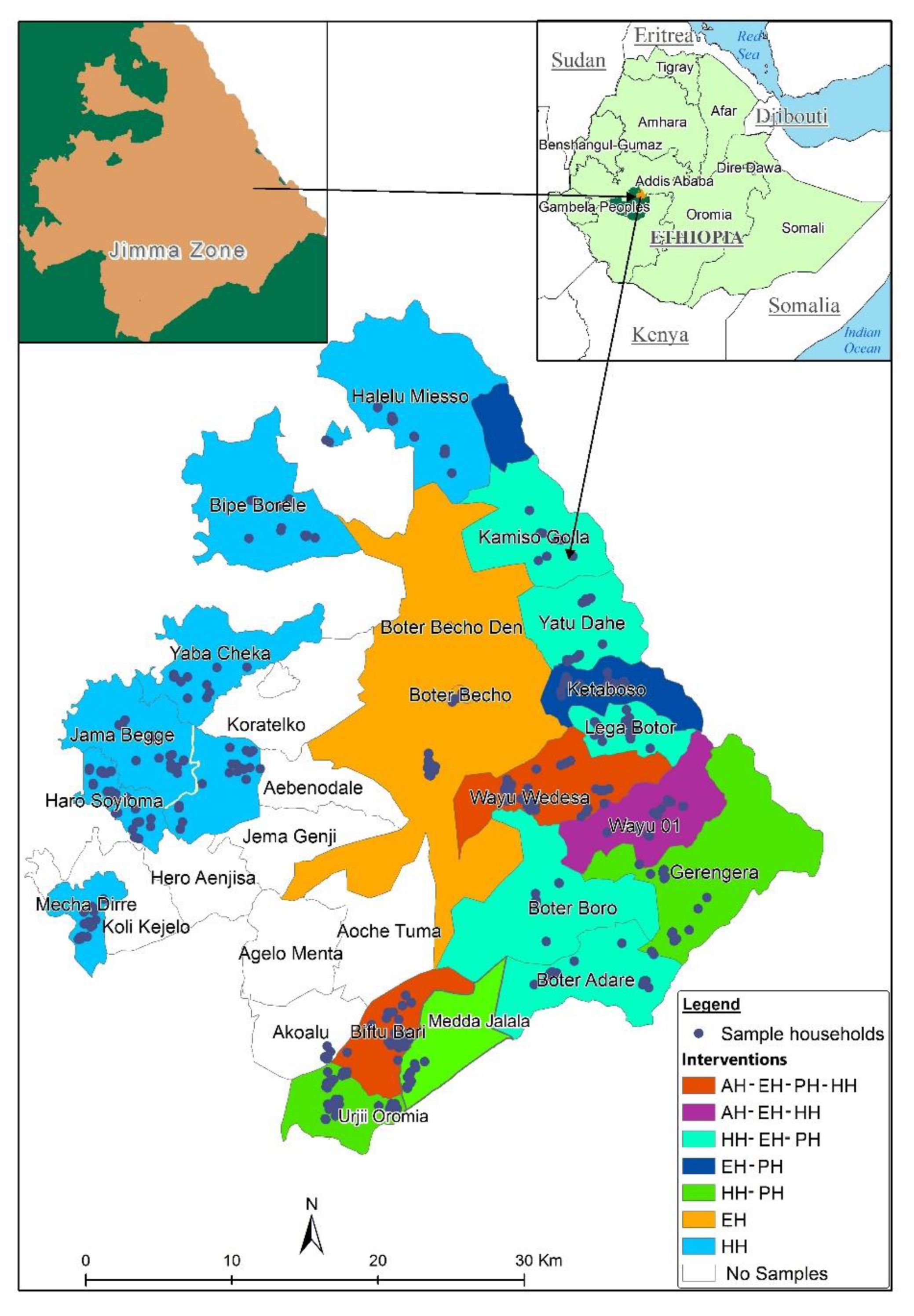
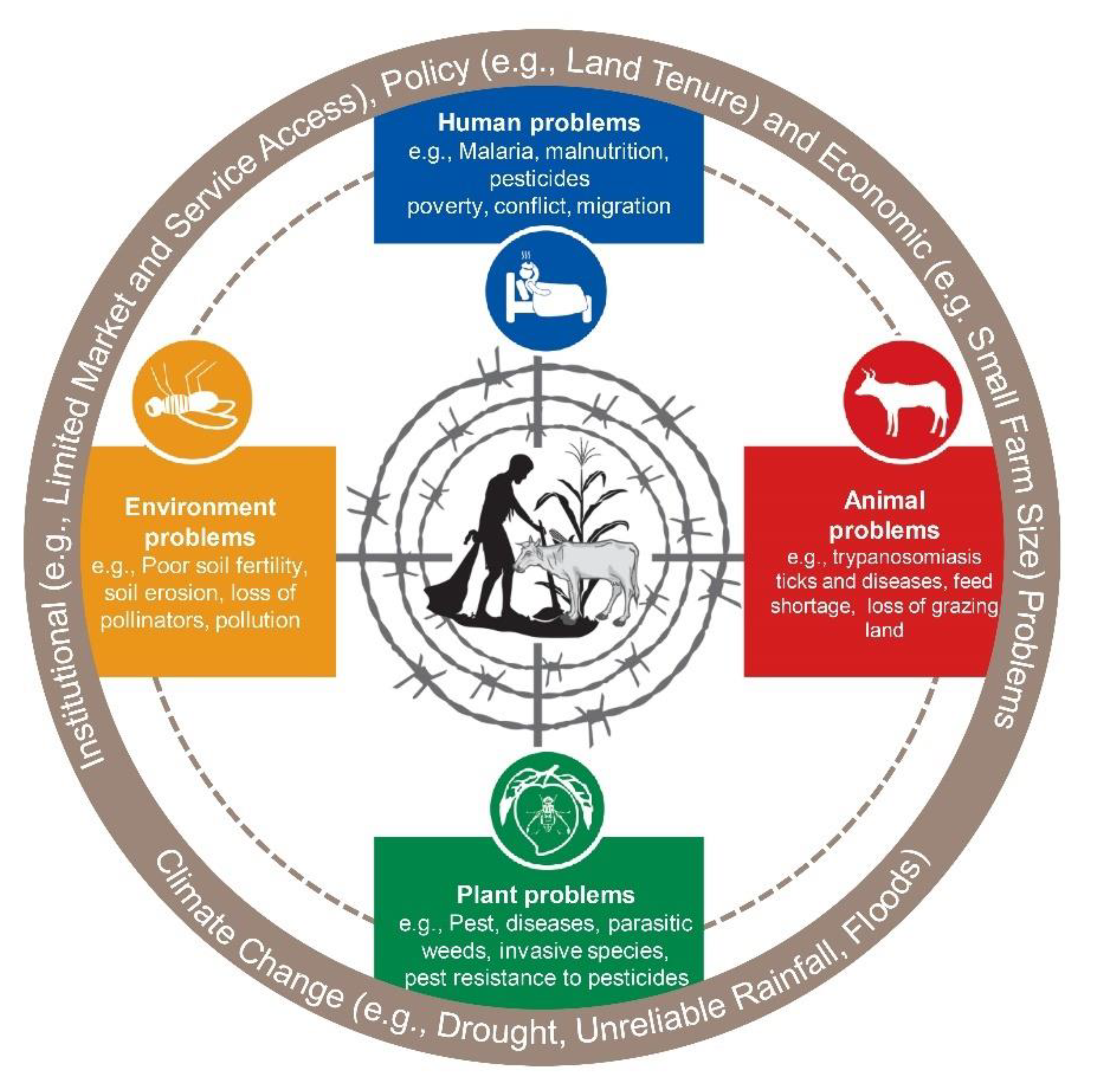
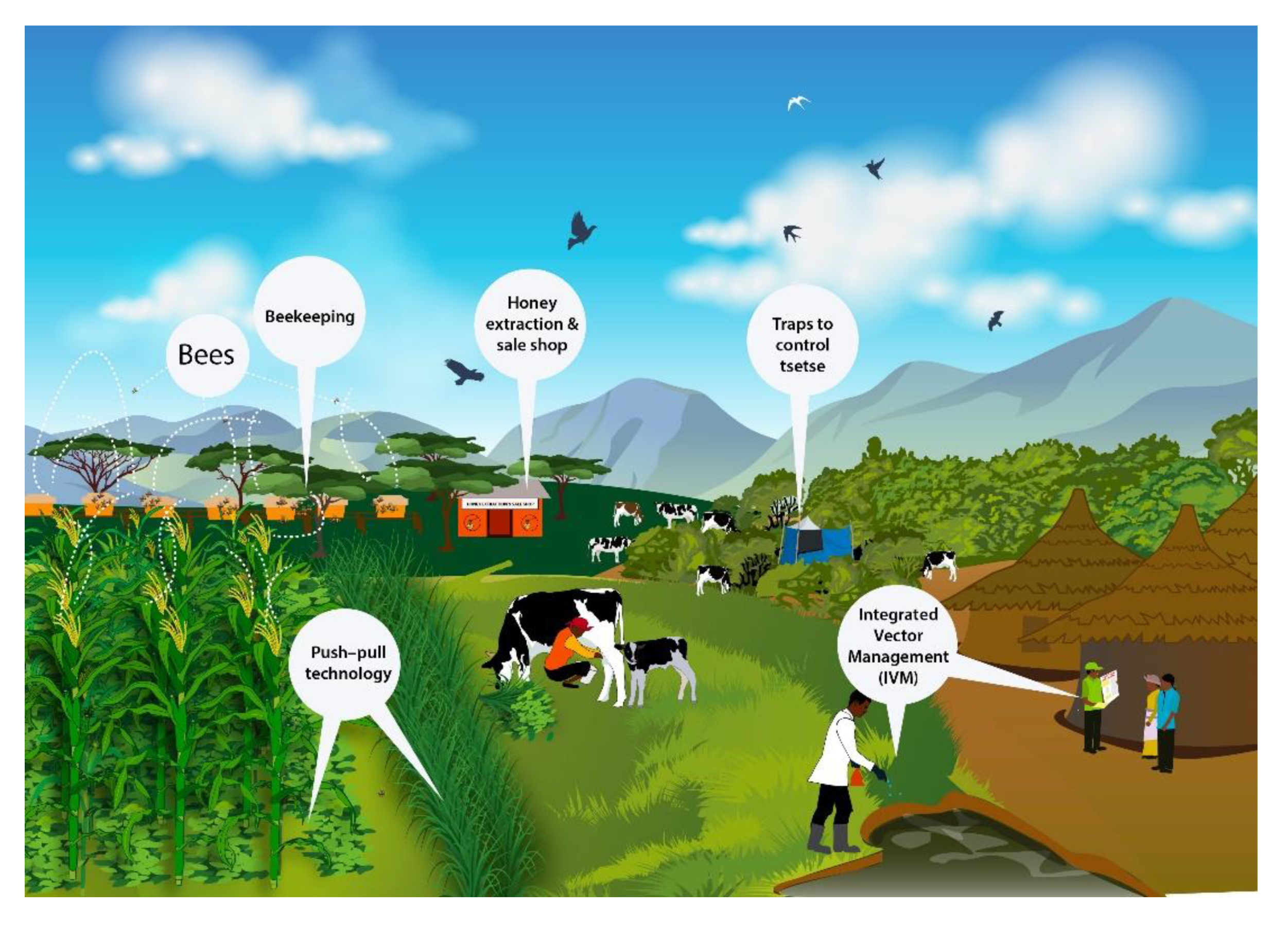
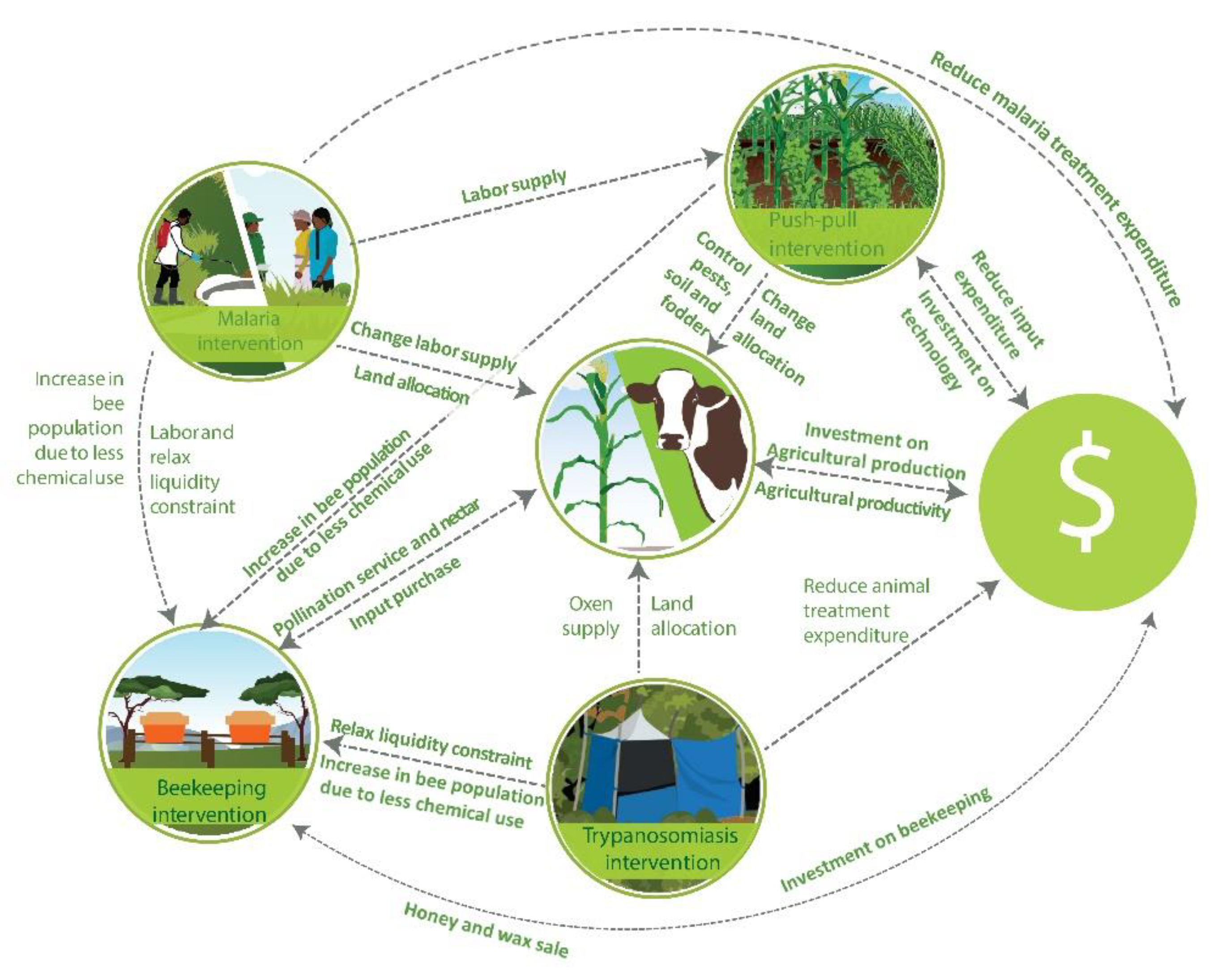
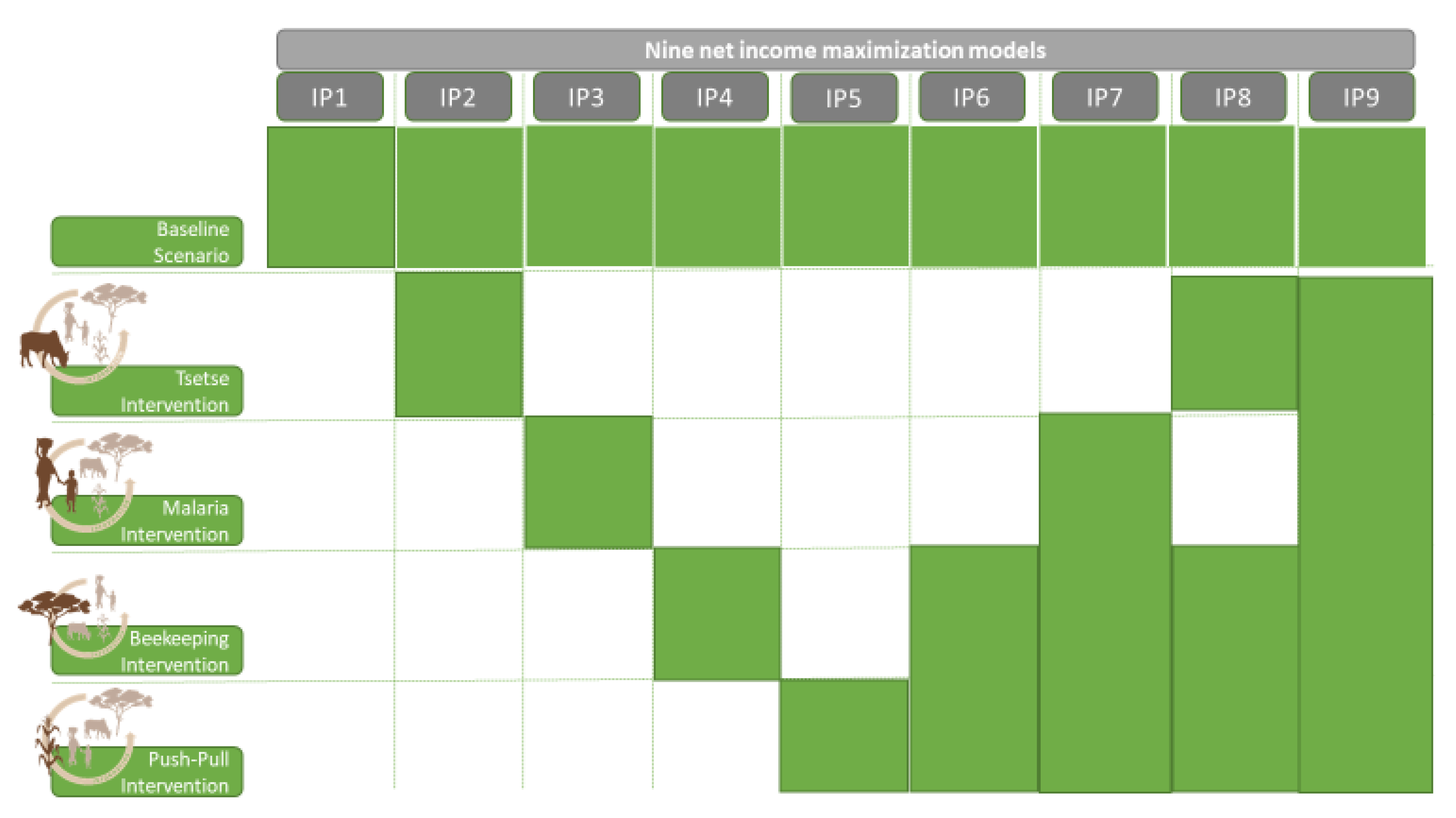

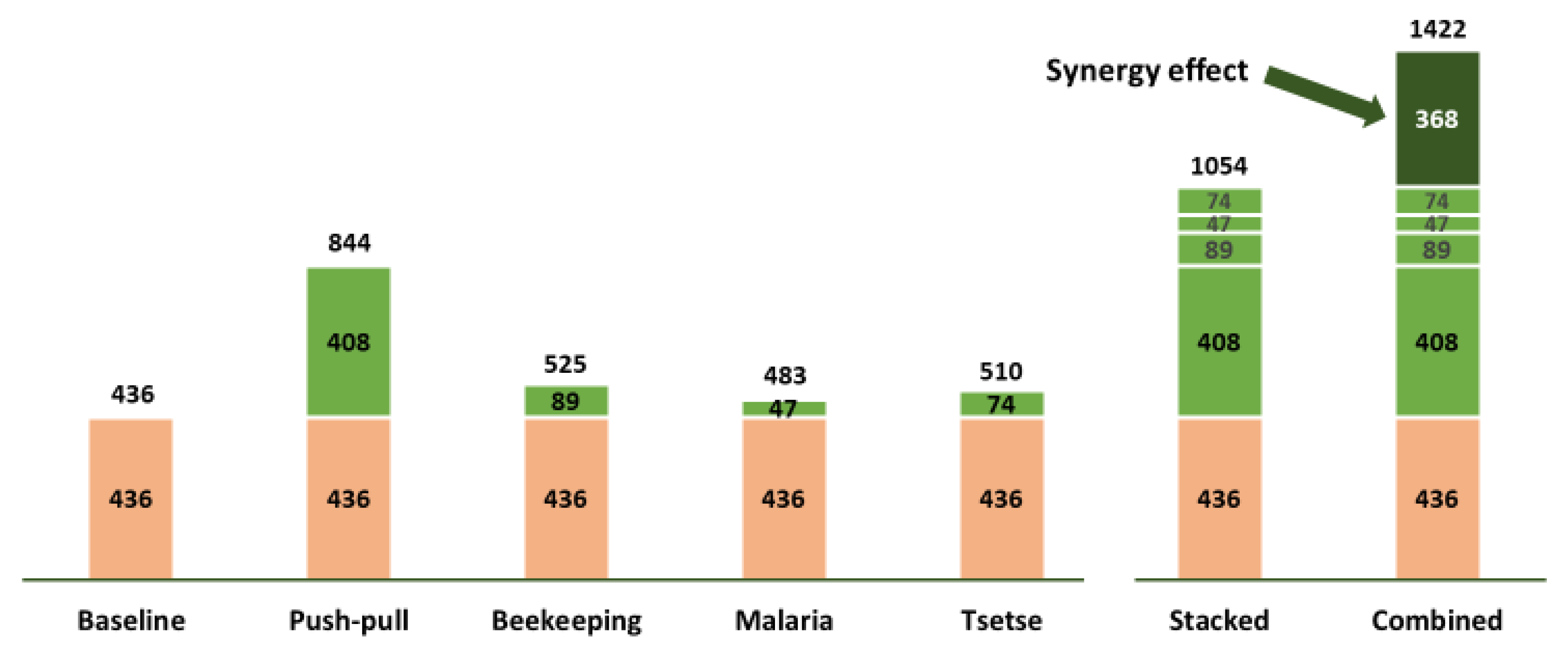
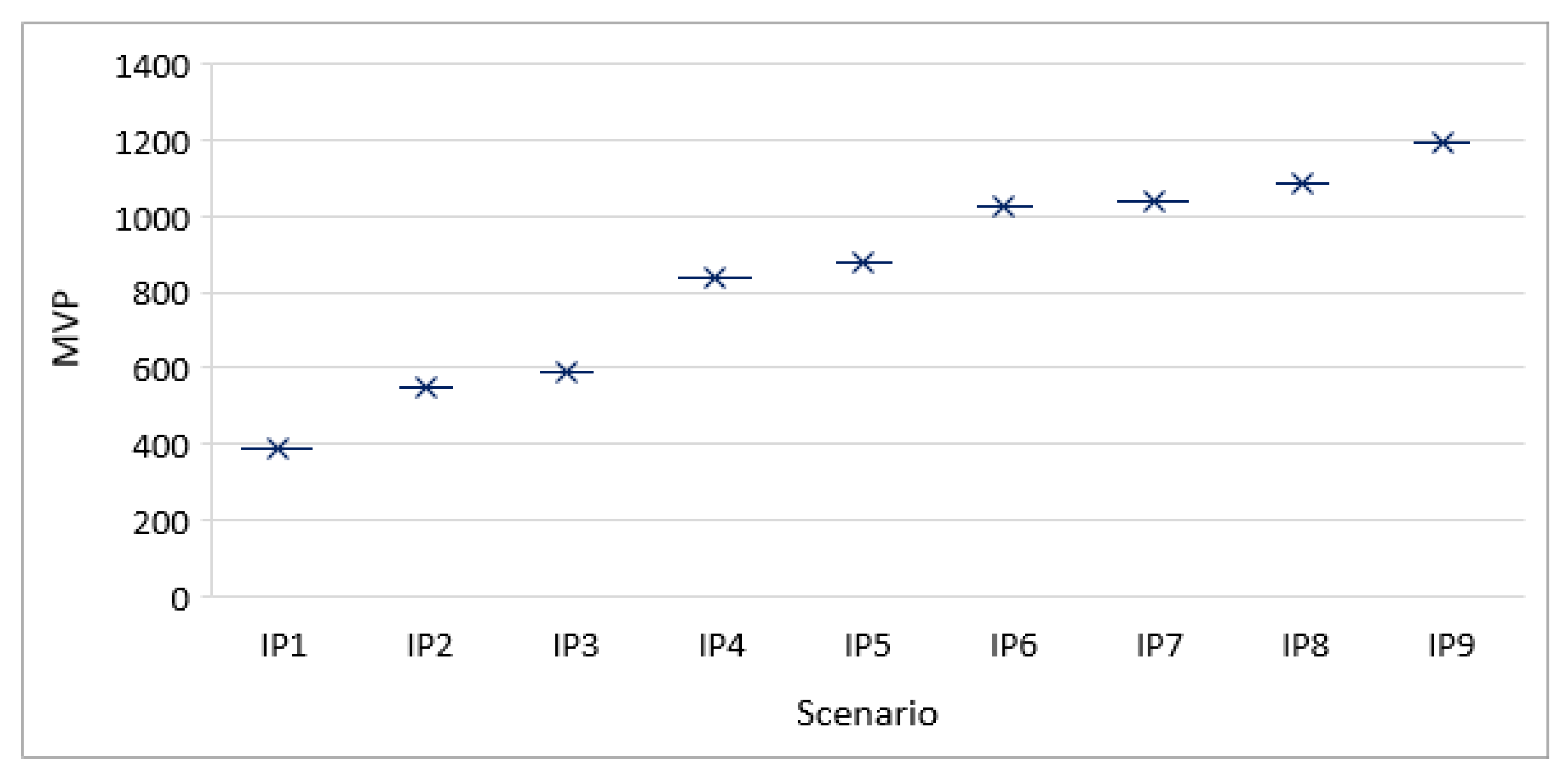
| Crop | Yield (kg/ha) | Unit Price (Ethiopian Birr-ETB/kg) | Per Capita Consumption (kg) |
|---|---|---|---|
| Maize | 3255 | 4 | 125 |
| Sorghum | 1359 | 4 | 62 |
| Chickpeas | 941 | 13 | 30 |
| Teff | 731 | 13 | 41 |
| Black pepper | 708 | 52 | 8 |
| Beans | 848 | 6 | 20 |
| Livestock Type | Unit Price (ETB per Head/kg) | Dry Matter Requirement (per Head) (kg) |
|---|---|---|
| Cow | 6150 | 1597 |
| Ox | 7000 | 2281 |
| Heifer | 4500 | 1141 |
| Bull | 4150 | 1141 |
| Male/female calf | 2200 | 456 |
| Female adult goat | 1300 | 228 |
| Male adult goat | 1700 | 228 |
| Kid male/female goat | 500 | 228 |
| Culled ox | 4500 | NA |
| Culled cow | 3500 | NA |
| Culled male goat | 700 | NA |
| Culled female goat | 700 | NA |
| Butter | 133 | NA |
| Stock Type/Parameter | Without Tsetse Control | With Tsetse Control | ||
|---|---|---|---|---|
| Disease Prevalence Rate (%) | Animal Mortality (%) | Disease Prevalence Rate (%) | Animal Mortality (%) | |
| Cattle | ||||
| Cows | 45 | 15 | 15 | 5 |
| Oxen | 70 | 30 | 20 | 8 |
| Calves | 30 | 20 | 10 | 5 |
| Heifers | 10 | 2 | 4 | 0 |
| Bulls | 10 | 2 | 4 | 0 |
| Goats | 55 | 20 | 30 | 10 |
| Average | 36.7 | 14.8 | 13.8 | 4.7 |
| Production and Productivity | ||||
| Calving interval (years) | 2 | 1 | ||
| Lactation length (months) | 6 | 6 | ||
| Milk production/cow/day (ℓ) | 2 | 3 | ||
| Ox power availability (%) | 50 | 100 | ||
| Treatment expenditure (ETB) | 1000 | 300 | ||
| Parameter | With Malaria | Without Malaria |
|---|---|---|
| Prevalence rate (%) | 100 | 15 |
| Treatment expenditure (Ethiopian Birr, ETB) | 4750 | 453 |
| Agricultural labor available (%) | 50 | 90 |
| Parameter | Parameter Value | |
|---|---|---|
| Maize yield (% from baseline yield) | Year 1= 10% increase Year 2 and above= 15% increase | |
| Desmodium dry matter (tons/ha) | 3.6 tons/ha | |
| Brachiaria dry matter (tons/ha) | 6.4 tons/ha | |
| Labor Demand for Maize Production (Person-Days/ha) | Non-Push–Pull Technology Maize Plot | Push–Pull Technology Maize Plot |
| Plowing and planting | 26 | Year 1 = 26, Year 2 = 10 |
| Weeding | 26 | Year 1 = 16, Year 2 = 8 |
| Harvesting and threshing | 22 | 34 |
| Livestock Productivity | ||
| Lactation length (months) | 6 | 8 |
| Milk yield per cow per day (ℓ) | 2 | 5 |
| Parameter | Traditional Beehives | Improved Beehives |
|---|---|---|
| Honey (kg per beehive per year) | 16 | 27 |
| Wax (kg per beehive per year) | 1.5 | NA |
| Lifespan (years) | 3 | 10 |
| Abscondment rate (%) | 10 | 5 |
| Honey price (ETB/kg) | 61 | 94 |
| Wax price (ETB/kg) | 250 | NA |
| Beehive price with colony (ETB) | 900 | 1435 |
| Intervention Options | Annual Income | Per Capita Income |
|---|---|---|
| Baseline model | 1584 | 436 |
| Integrated vector management (IVM) package intervention for malaria | 1753 | 498 |
| Trap intervention for trypanosomiasis | 1850 | 510 |
| Push–pull technology intervention for stemborer infestations | 3065 | 844 |
| Improved beekeeping intervention | 1904 | 525 |
| Push–pull technology + improved beekeeping interventions | 4101 | 1130 |
| Push–pull technology + improved beekeeping + IVM intervention | 4417 | 1217 |
| Push–pull technology + improved beekeeping + trap intervention | 4485 | 1236 |
| Push–pull technology + improved beekeeping + IVM + trap intervention | 5163 | 1422 |
© 2020 by the authors. Licensee MDPI, Basel, Switzerland. This article is an open access article distributed under the terms and conditions of the Creative Commons Attribution (CC BY) license (http://creativecommons.org/licenses/by/4.0/).
Share and Cite
Kassie, M.; Abro, Z.; Wossen, T.; T. Ledermann, S.; Diiro, G.; Ballo, S.; Belayhun, L. Integrated Health Interventions for Improved Livelihoods: A Case Study in Ethiopia. Sustainability 2020, 12, 2284. https://doi.org/10.3390/su12062284
Kassie M, Abro Z, Wossen T, T. Ledermann S, Diiro G, Ballo S, Belayhun L. Integrated Health Interventions for Improved Livelihoods: A Case Study in Ethiopia. Sustainability. 2020; 12(6):2284. https://doi.org/10.3390/su12062284
Chicago/Turabian StyleKassie, Menale, Zewdu Abro, Tesfamicheal Wossen, Samuel T. Ledermann, Gracious Diiro, Shifa Ballo, and Lulseged Belayhun. 2020. "Integrated Health Interventions for Improved Livelihoods: A Case Study in Ethiopia" Sustainability 12, no. 6: 2284. https://doi.org/10.3390/su12062284
APA StyleKassie, M., Abro, Z., Wossen, T., T. Ledermann, S., Diiro, G., Ballo, S., & Belayhun, L. (2020). Integrated Health Interventions for Improved Livelihoods: A Case Study in Ethiopia. Sustainability, 12(6), 2284. https://doi.org/10.3390/su12062284





